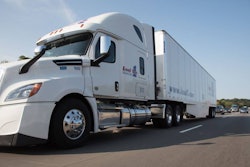 During the past two years, Load One has developed technologies to gain distinct advantages by bringing office staff and drivers as close as possible to optimizing their workflows. Photo by Mary Rosecrans.
During the past two years, Load One has developed technologies to gain distinct advantages by bringing office staff and drivers as close as possible to optimizing their workflows. Photo by Mary Rosecrans.One of Load One’s most recent developments is a system that speeds response times to customer offers and bid requests.
When the company receives an offer, the system does a radius search to find available trucks and drivers in the area based on their location and HOS data. With a click of a button, a dispatcher can send relevant information about the load offer to all drivers in the area.
Drivers receive an instant notification in the app to accept or decline the offer immediately. Drivers also receive an automated phone call that reads them relevant information about the load. They can respond hands-free by voice to accept or decline.
The company still dispatches with the FIFO method, but now it has a near-instant response from all drivers in the area, which speeds the process for covering loads from customers. Previously, dispatchers called drivers in order of dispatch. Each call would take several minutes, and roughly 40 percent of the time, the customer already had found another carrier before they responded, Elliott says.
With the new system, Load One averages 60 seconds to have responses from all drivers in the area, De Leon says. Dispatchers have a screen that shows the responses on each load using a traffic signal icon for the status — green for accepted, yellow for expired and red for declined. As soon as a light turns green, dispatchers know they can accept the customer’s offer.
With the technology, the company has increased its load securement between 10 and 15 percent, which has increased revenue for Load One and its drivers, Elliott says.
If Load One does not have a driver available, dispatchers also can use the system to offer the load to partner carriers as a broker through the company’s integration with Sylectus. Also, the technology integrates with the websites of air freight and less-than-truckload providers to look up rates and give Load One operators the tools they need to provide customers with a total solution.
Holding onto drivers
 Once drivers become familiar with Load One’s mobile app, “if they go to a competitor, they lose that technology,” says CEO John Elliott. “It’s hard to take that step back.” Photo by Mary Rosecrans.
Once drivers become familiar with Load One’s mobile app, “if they go to a competitor, they lose that technology,” says CEO John Elliott. “It’s hard to take that step back.” Photo by Mary Rosecrans.The expedite segment’s unpredictable demand plays a factor in driver turnover. The technology Load One developed is helping to further reduce its already low turnover rate. Last year, the company had a 24.6 percent turnover rate, and Elliott believes it will be under 20 percent this year.
Once drivers become familiar with the tool, “if they go to a competitor, they lose that technology,” says Elliott. “It’s hard to take that step back.”
The app has a 95-percent fleet adoption, and a recent survey of users generated a positive rating of 98 percent.
More importantly, Load One has been able to grow capacity and revenue without adding trucks by scaling its efficiencies to secure loads faster than its competitors.
“We are trying to give predictive analytics to a very unpredictable industry and market,” says Elliott. “I think we’ve taken it further than anyone in the industry.”
About the award
Commercial Carrier Journal’s editors recognize innovators throughout the year and select one for special recognition as the CCJ Innovator of the Year. Innovators considered for the current award were those recognized in the magazine in 2018.
Innovation in any aspect of the operation is eligible for recognition. To qualify, the carrier must operate at least 10 power units in Classes 3-8 and maintain a satisfactory safety rating, if rated. Selection of innovators for recognition is at the sole discretion of CCJ’s editorial staff.
This year’s award was announced and presented at the CCJ Innovators Summit, a networking event for current and prior-year CCJ Innovators held Feb. 7-9 in Key Largo, Fla. Representatives of the innovative trucking operations updated one another on their initiatives.
The CCJ Innovators program is sponsored by Cummins, Freightliner Trucks, Omnitracs and Shell Lubricants. For more information on the program and links to previously recognized CCJ Innovators or to fill out the online nomination form, go to CCJInnovators.com, or contact Jeff Crissey, CCJ editor, at 205-248-1244.















